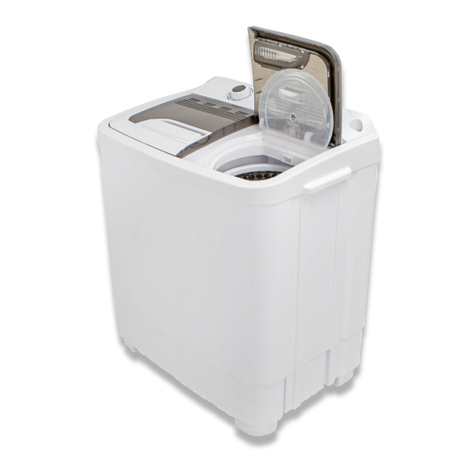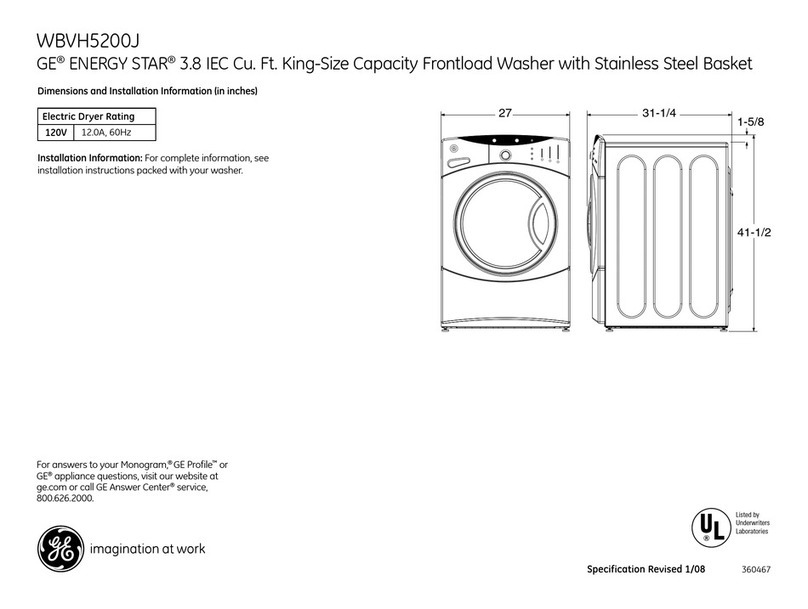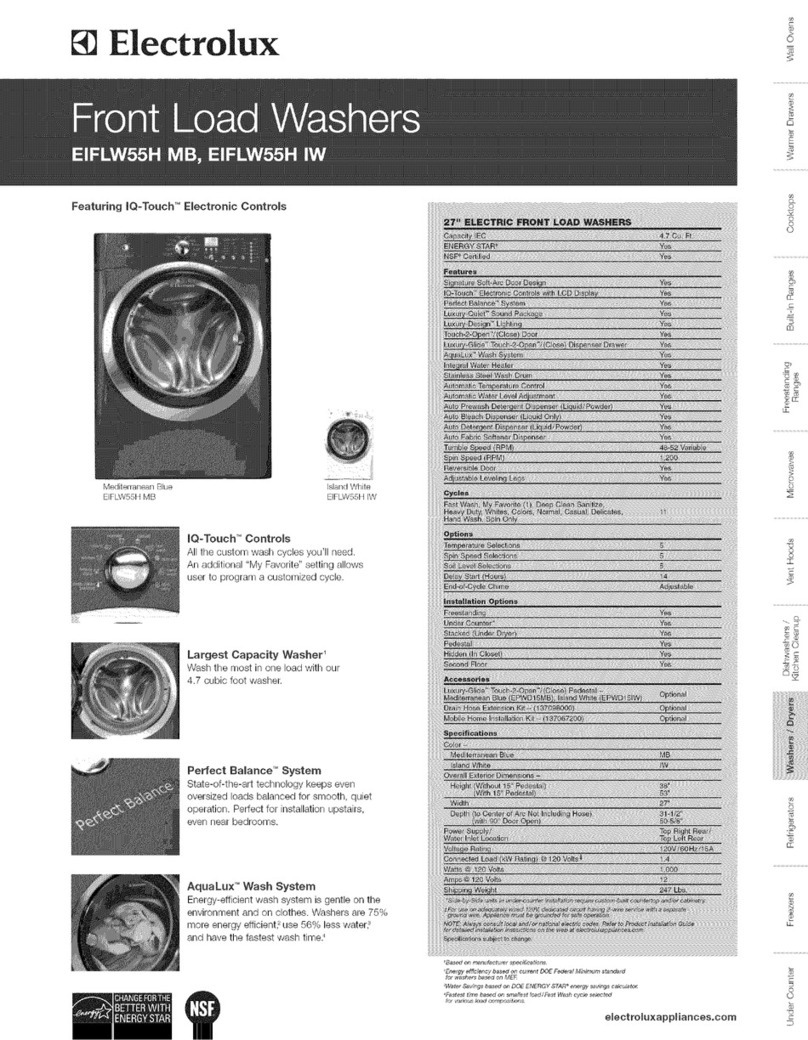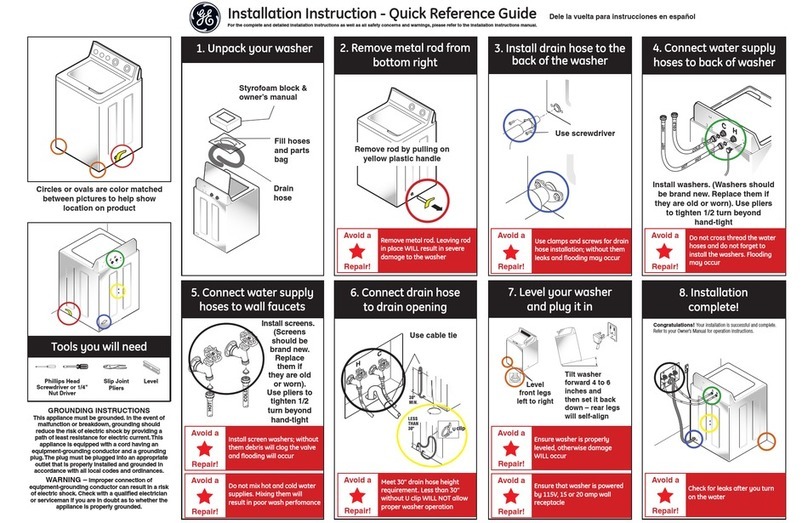Barton 99809 Original instruction manual

AUTOMATIC WASHER
SAVE THIS MANUAL: KEEP THIS MANUAL FOR SAFETY WARNINGS, PRECAUTIONS, ASSEMBLY,
OPERATING, INSPECTION, MAINTENANCE AND CLEANING PROCEDURES. WRITE THE PRODUCT’S
SERIAL NUMBER ON THE BACK OF THE MANUAL NEAR THE ASSEMBLY DIAGRAM (OR MONTH
AND YEAR OF PURCHASE IF PRODUCT HAS NO NUMBER).
OWNER’S MANUAL AND SAFETY INSTRUCTIONS
ITEM: 99809
FOR QUESTIONS PLEASE CALL OUR CUSTOMER SUPPORT: (909) 628-0880 MON-FRI 9AM TO 3PM PST

IMPORTANT SAFETY INFORMATION
GENERAL SAFETY WARNINGS
Read all safety warnings and instructions. Failure to follow the warnings and instructions
may result in electric re and/or serious injury. Save all warnings and instructions for future
reference.
SAFETY
The warnings, precautions, and instructions discussed in this instruction manual cannot cover
all possible conditions and situations that may occur. It must be understood by the operator that
common sense and caution are factors which cannot be built into this product, but must be supplied
by the operator. Read carefully and understand all ASSEMBLY AND OPERATION INSTRUCTIONS
before operating. Failure to follow the safety rules and other basic safety precautions may result in
serious personal injury.
1
Read and understand all instructions. Failure to follow all instructions may result in serious injury or
property damage.
DO NOT allow persons to operate or assemble the product until they have read this manual and have
developed a thorough understanding of how it works.
DO NOT modify this product in any way. Unauthorized modication may impair the function and/or
safety and could affect the life of the product. There are specic applications for which the product was
designed.
This appliance is for household use only. It is not intended for commercial, Maritime or RV applications.
The appliance is intended for indoor use only. DO NOT use outdoors.
Use only detergents or softeners recommended for use in this manual and keep them out of the reach
of children.
DO NOT unplug your appliance by pulling on its power cord. ALWAYS grasp the plug rmly and pull it
straight out from the outlet.
DO NOT operate any appliance that has a damaged cord or plug, if it is damaged or malfunctions in any
way, or if the outlet is not in proper working order. Contact customer service or a service technician.
ALWAYS turn off and unplug from outlet before servicing, changing accessories or cleaning the unit.
Allow unit to cool down completely before cleaning, moving or servicing. Turning the unit off does not
disconnect it from the power source.
DO NOT put anything ammable or explosive in, on, or near the appliance. DO NOT wash articles of
clothing or items that have been soaked in ammable or explosive chemicals.
ALWAYS wait for the washer tub to completely stop moving before reaching in to add or remove any
clothes.
DO NOT wash clothes that have been previously exposed to gasoline, solvents or other ammable
substances.
DO NOT operate this washer unless all enclosure panels are properly installed.
DO NOT tamper with or modify the controls.

IMPORTANT SAFETY INFORMATION
2
WARNING: Risk of child entrapment. DO NOT allow children to play on or in the appliance. Close
supervision of children is necessary when the appliance is used around them.
The appliance must be plugged into a properly installed and grounded outlet that meets the voltage
requirements listed on the ratings label.
CAUTION: The power cord is equipped with a 3-prong grounding plug to protect against shock hazards.
ALWAYS plug the cord into a properly installed and grounded 3-prong wall receptacle, and DO NOT
remove the grounding prong.
Keep the fuel supply hose away from any heated surfaces.
Under certain conditions, hydrogen gas may be produced in a household hot water system that has not
been used for two weeks or more. Hydrogen gas is highly explosive. If the hot water system has not been
used for more than two weeks, turn on all hot water faucets and let the water ow for several minutes
prior to using your compact washer.
DO NOT modify or repair the unit by yourself. Contact customer service or a qualied service technician if
service is required.
To reduce the risk of electric shock or re, DO NOT use an extension cord or outlet adapters to connect
the unit to an electrical power source. The appliance must be properly grounded using a three-prong
electric receptacle wall outlet.
DO NOT install the washing machine in a moist or wet area, or where it can get wet. DO NOT spray with
water when cleaning.
DO NOT put children on top of, or allow children to climb in or on, the washer.
Regularly clean the power plug to remove dust and dirt, in order to prevent electrical failure.
It is recommended to unplug the unit when it is not in use.
ALWAYS be sure to properly and securely connect the power cord to the outlet, and the water hoses to
prevent leakage or electrical shock.
DO NOT operate the unit or handle the plug with wet hands.
DO NOT ground the appliance to a gas pipe, plastic water pipe or telephone line. Improper grounding
may lead too electric shock.
DO NOT wash raincoats, heavy jackets, or similar, heavy items.
DO NOT put heavy or hot items on top of the machine.
DO NOT wash laundry soaked with petrol and organic solvent.
DO NOT share on power source with other appliances. DO NOT use an unappointed power source.
Keep the plug strip clean.
DO NOT place the machine in the bathroom. Such action may damage the electrical insulation and
cause the body to rust.
Plug the power cord into an AC 120V/60Hz wall socket rated at 15 AMPS or higher. Use the socket for
this appliance only. DO NOT use an extension cord.
DO NOT use an electric transformer. It could result in electric shock or re.
Remove all foreign substances such as dust or water from the power plug terminals and contact points
using a dry cloth on a regular basis.

3
PARTS DIAGRAM AND LIST
SAVE THESE WARNINGS
DO NOT hook the power cord over a metal object, place a heavy object on the power cord, insert the
power cord between object or push the power cord into the space behind the appliance. This may result
in electric shock or a re.
DO NOT pull or excessively bend the cord on this appliance. Unplug by pulling on the plug itself.
Make sure the socket you use is grounded in accordance with local and national codes.
DO NOT install this appliance near a heater or other ammable material.
DO NOT install on carpet. Install only on a level and solid oor that can support its weight.
This washer is heavy, installation is a two-person job.
Store and install the washer where it will not be exposed to below freezing temperatures, or extreme
weather conditions.
If the appliance is ooded, cut the power immediately and contact your nearest service center.
If the appliance emits a strange noise, a burning smell or smoke. unplug the power plug immediately and
contact your nearest service center. Failing to do this may result in electric shock or re.
In the event of a gas leak, ventilate the area immediately. DO NOT turn any appliance or light on or off.
DO NOT use a ventilating fan, a spark may result in re or explosion.
DO NOT force the washer lid open while the washer lid is open. Water owing out of the washer may
cause burns or spill on the oor. Forcing the lid open may cause damage to the product.
Make sure to remove the packaging (sponge, Styrofoam) attached to the bottom of the machine before
using it.
DO NOT mix chlorine bleach with ammonia or acids such as vinegar. This can produce poisonous gas,
resulting in serious injuries.
If any foreign substance such as water enters the appliance in any area other than the tub, unplug the
appliance and contact your nearest service center.
DO NOT reach into the washer parts are moving. Before loading, unloading or adding items, press the
START/PAUSE button and allow the basket to come to a complete stop before reaching inside. Failing to
do so may cause serious injury.
Open the faucet slowly after a long period of non-use. The air pressure in the water supply hose or the
water pipe may result in damage to a part in water leakage.
Ensure that the water inlet pipe is connected and the tap is opened before washing clothes.
DO NOT use regular hand washing soap in the washer. It can harden over time and cause problems for
the washer.
DO NOT wash comforters rugs or doormats. These items are too heavy for the washer and may cause
abnormal vibrations within the washer.

4
INSTALLATION and PARTS
UNPACKING AND REMOVING THE SHIPPING MATERIAL:
Remove the packing box and lift the washer up and away from the Styrofoam base cushion. Open the lid of
the washer to take out all accessories including the protective foam.
Packaging materials can be
dangerous to children; keep
all packing material well out
of the reach of children.
DO NOT operate the washer
on the foam base cushion.
Failing to do so will result in
serious vibration.
PARTS DIAGRAM

5
INSTALLATION INSTALLATION
ACCESSORIES
TOOLS NEEDED FOR INSTALLATION
KEY DIMENSIONS AND SPECIFICATIONS
CHOOSING THE PROPER LOCATION
FLOORING: For the best performance, you must install your washer on a solidly constructed oor. Wood
oors may need to be reinforced to minimize vibration and/or unbalanced load situations. Carpeting and soft
tile surfaces are contributing factors to vibration which can cause your washer to move slightly during the spin
cycle.
DO NOT install your washer in areas where water may freeze. Since your washer retains some water in
its water valve, pump and hose areas. Frozen water can damage the belts, pump and other components.
NEVER install on a platform or weakly supported structure.
ELECTRIC
Use 120V/60Hz 15 AMPS fuse or circuit breaker. Individual branch circuit serving only for your washer is
recommended. NEVER use an extension cord with this appliance.
GROUNDING: Electrical grounding is required for this washer. In the event of a malfunction, grounding
will reduce the risk of electric shock by providing a path of least resistance for the electric current. This
appliance is equipped with a power cord having a three-prong grounding plug for use in a properly installed
and grounded outlet. The plug MUST be plugged into an appropriate outlet that is properly installed and
grounded in accordance with all local codes and ordinances.
NEVER connect the ground wire to plastic plumbing lines, gas lines or hot water pipes.
DIMENSIONS: 400X430X720mm
PACKING SIZE: 505X515X780mm

6
INSTALLATION
WATER
To correctly ll your washer in the proper amount of time. Water pressure of 14 to 70PSI (100 to 500 kPa) is
required. Water pressure less than 14psi may cause water valve failure, or may not allow the water valve to
shot off completely or can extend the ll time beyond what your washer controls allow, causing your washer
to turn off and alarm error. A time limit is built into the controls to prevent ooding in your home if a hose
becomes loose. The water faucet must be within 4 feet (122cm) of the back of your washer. To avoid the
possibility of water damage, have the water faucets easily accessible. Turn off faucets when washer is not
in use. Periodically check that there is no leakage from the water inlet ttings.
DRAIN FACILITY: The recommended height of the standpipe is 35” or 90cm. The drain hose must be
routed through the drain hose clip to the standpipe. The standpipe must be large enough to accept the
outside diameter of the drain hose.
INSTALLING THE WASHER
STEP 1. Tilt the unit back onto its rear rollers and push it forward as shown. Move the unit to a location as
described in the previous location section. Make sure the surface is level and without carpeting.
STEP 2. Slide the bottom cover into the slots on the bottom surface of the unit as in the following gure and
x it with two screws attached with the unit.

INSTALLATION INSTALLATION
STEP 1. The quick connection adaptor is primarily for quick connection to a single faucet, such as a kitchen
sink. Skip this step if you are connecting the washer to a sink with separate hot and cold faucets the adaptor
consists of two parts that quickly connect or disconnect. One part, the faucet tting, is for connection to the
faucet and the other part, the hose tting, connects to the cold water hose of the washer.
Pull back on the white ring to free the faucet tting from the adaptor for installation into the faucet.
Screw the end of the cold water hose onto the base of the hose tting.
If the faucet has internal screw threads, unscrew the aerator if present from the tip of the faucet. Then
screw the faucet tting into the faucet. Make sure the black rubber gasket is on top of the adaptor before
screwing it in.
If the faucet has external screw threads, remove the gasket from the top of the faucet tting and screw
the tting over the external threads.
Pull back on the white ring to connect the two parts of the adaptor back together.
NOTE: When connected to a single faucet that can dispense either hot or cold water, both hot and cold
water can be run through the cold water line for washing use. However, it is recommended to only run cold
water washes when the adaptor is connected to such a faucet.
STEP 2. Connect the ends of the water supply hoses to the HOT and COLD faucets. For convenience, use
the quick connection adaptor for connection to the cold water faucet.
STEP 3. Tighten the ttings by hand until they are snug, then tighten them an additional 2/3 of a turn with a
wrench.
When you fasten the ttings, do not fasten them too tightly or apply tape or sealant to the faucets or water
supply intakes. This can damage the ttings. After you have connected the water supply hoses to the
faucets, ensure that they are connected securely by pulling the water supply hoses downwards.
STEP 4. Place the unconnected ends of the hoses into a bucket and open the faucets
connected to the two water supply hoses for 10-15 seconds to remove any foreign
substances from the hoses. Close the faucets before continuing.
STEP 5. Connect the ends of the water supply hoses to the water supply intake connections at the back of
the washer.
The water supply hose connected to the HOT faucet
must be connected to the hot water supply intake and
the water supply connected to the COLD faucet must
be connected to the cold water supply intake.
7

INSTALLATION
Conrm that the water supply hoses are not twisted or bent. If the hoses are twisted or bent, the hoses can
leak and cause electric shock due to the water leakage. To ensure the correct water usage, connect both the
HOT and COLD water faucets. If wither or both are not connected, an error code can occur. If you do not want
to use the HOT water supply hose, install the water intake cap into the HOT water supply intake hole. In this
case, you must select cold water as the wash temperature option.
STEP 6. Tighten the ttings by hand until they are snug, then tighten them an additional 2/3 of a turn with a
wrench.
STEP 7. Turn on the HOT and COLD water supplies and check all the water supply intake connections and
the faucets for water leaks.
CONNECT THE DRAIN HOSE
Position the other end of the drain hose. It can be positioned in three
ways.
A. Over the edge of the basin. Secure the guide to the side of the
basin wall with a hook or to the tap with a piece of string to prevent the
drain hose from moving.
B. In a standpipe. The standpipe must be no shorter than 32” and no
longer than 39”.
C. In a laundry tub, The laundry tub must be no shorter than 32” and
no higher than 39”.
NOTE: Make sure the connection between the drain hose and the
wash basin, standpipe or laundry tub is not airtight.
LEVELLING YOUR WASHER
1. Slide the washer into position, then open the lid of the washer and
pour the water into the tub to just below the pulsator level.
2. If the washer is level, the pulsator is positioned at the center of the
washer as shown. If not, level your washer by turning the front leveling
feet clockwise or counter-clockwise as necessary.
8

OPERATION OPERATION
POWERING YOUR WASHER
1. Plug the power cord into a 3-prong, well grounded 120V/60Hz approved outlet protected by a 15 AMP fuse
or comparable circuit breaker
RUNNING A TEST CYCLE
1. Load about 6lbs of laundry into the tub. Then press the POWER button to turn on your washer.
2. Press the POWER button to turn on your washer.
3. Select the RINSE + SPIN cycle by pressing the FUNCTION to turn ON the RINSE and SPIN lights.
4. Press the START/PAUSE button to start the test cycle.
5. The washer should not rock or vibrate excessively when the water is supplied or when washing or spinning
and should drain well during the spin cycle.
If water leaks while water is being supplied or drained, check the water connections, If the washer rocks and
vibrates excessively, level your washer again.
STORING YOUR WASHER
If you want to store your washer at another location, unplug it, drain any remaining water from the drain pipe
and hook the pipe onto the back of the washer. Disconnect the water inlet hoses from the faucets and move
the washer to a new location.
CONTROL PANEL
POWER: Press the POWER button once to turn on the power of the washer. Press
again to turn off the unit.
START/PAUSE: Press the START/PAUSE button once to start the wash cycle. Press
the button during operation to pause the cycle. Press again to continue the cycle.
PROGRAM: Press this button to select the desired washing program.
9

OPERATION
TIMER: The digital display will show and count down the estimated minutes for the cycle
selected. You can choose how much time you need to wash or spin the cycle.
WATER LEVEL: Press this button to select your desired water level, depending on the size
of the load you want to wash.
V-CHIP (CHILD LOCK): This function can help to prevent children from changing the
operation status of the unit. While the machine is running, press “Water Level” and “Preset”
for 3 seconds at the same time, enter the “V-Chip” function.
WASHING A LOAD OF WASHER
POWER YOUR WASHER: Press the ON/OFF button to power the washer on.
LOAD YOUR WASHER: Sort laundry by fabric type, coil level, color and load size as needed. DO NOT
overll the tub more than 3/4 full.
TO ADD A FORGOTTEN ITEM: Press the START/PAUSE button to PAUSE the washer. Wait for the tub to
stop spinning, then open the door. Add the item, close the door and press the START/PAUSE button. The
cycle will resume.
ADDING DETERGENT: This washer is designed for high efciency powder detergent only. Draw the
compartment out and add the recommended amount of detergent directly into the detergent compartment
before starting your washer. The normal amount of detergent to use is 1/4 to 1/2 of the maximum amount
recommended by the detergent manufacturer. Always reduce the amount of detergent of the load is small
or lightly soiled, or if your water is very soft. Never use more than the maximum amount recommended by
the detergent manufacturer.
NEVER pour liquid bleach directly onto the load. It can cause fabric damage, such as weakening of
cloth bers or color loss.
SELECTING YOUR DESIRED CYCLE OPTIONS
1. First, select your desired washing program. The AIR DRY cycle can help remove some moisture from
clothing to reduce drying time and cost.
10

OPERATION OPERATION
2. Second, select the water level based on a High, Medium or Low load size. Press the
Load Size button to change the water level setting.
3. Third, select your desired wash cycle steps. If you want the wash cycle to perform
all three steps, just keep them lit. Pressing the button will change the number of steps
performed. In addition to WASH/RINSE/SPIN you can select WASH/RINSE, RINSE/SPIN,
WASH or SPIN.
4. Fourth, select your desired water temperature for washing action. For some cycles,
options in this function will be limited accordingly. Cold light only indicates Cold Water
selection. Both Cold and Hot light up together indicate Warm Water selection. Hot light only
indicates Hot water selection.
NOTE: The temperature setting is just for washing action. Rinsing action is cold water only
for all cycles.
5 (Optional). Lastly, you may delay the start time for washing if desired. Press the DELAY
button. The Display will change from minutes to hours. Each further press of the DELAY
button will add one hour to the display up to 24 hours, Now each further press will add 6
hours to the display up to 48 hours. One more press will cancel the Delay function and the
Display light will turn off.
6. Press the START/PAUSE button to start the washing cycle. When the washing cycle
begins, the estimated time in minutes for the cycle to complete will show and count down
in the digital display. Or, if the Delay Start is set, the display will count down the hours until
the cycle begins and then change to a minute countdown for the cycle.
NOTE: If you want cancel the DELAY START function after it is started, you should power
off the unit and reset all functions before restart the unit.
CONTROL LOCK: Press and hold the FUNCTION and LOAD SIZE buttons at
the same time to activate this function. The digital display will show “CL. The CL
and remaining time or Delay Start time will be displayed in turn. When the Control
Lock is activated, no buttons will function except for POWER and the ability to
deactivate the Control Lock as described above.
11

OPERATION
CYCLE GUIDE
CLEANING AND MAINTAINING THE MACHINE
Cleaning the Exterior: Turn off the water faucets after nishing the day’s washing. This will shut off the water
supply to your washer and prevent damage from escaping water. Leave the lid open to allow the inside of
your washer to dry out. Use a soft cloth to wipe up all the detergent. Clean the following as recommended:
Cleaning the Control Panel: Clean with a soft, damp cloth. Do not use abrasive powders or cleaning pads.
Do not spray cleaners directly onto the panel.
Cleaning the Interior: Clean the interior of your washer periodically to remove any dirt, soil, odor, mold,
mildew or bacterial residue that may remain in your washer as a result of washing clothes.
Cleaning the Tub: Run an express cycle with some bleach every month to clean the tub. This will also help
to remove mold which may occur inside the washer.
Cleaning the Lint Filter: There is a built-in lint lter in your washer. It can help to collect lint during washing
cycle. It is suggested to clean the lint lter every 10 cycles. Take it out and clean the lter with water. Then
place it back in the washer.
Cleaning the Pump Filter: There is a pump lter in your washer. It can help to protect the pump during
washing cycle. Clean the pump lter once every month.
12

TROUBLESHOOTING TROUBLESHOOTING
13

TROUBLESHOOTING
14

TROUBLESHOOTING TROUBLESHOOTING
13

TROUBLESHOOTING
14

15
TROUBLESHOOTING TROUBLESHOOTING

16
TROUBLESHOOTING

17
THE MANUFACTURER AND/OR DISTRIBUTOR HAS PROVIDED THE PARTS LIST AND ASSEMBLY
DIAGRAM IN THIS MANUAL AS A REFERENCE TOOL ONLY. NEITHER THE MANUFACTURER OR
DISTRIBUTOR MAKES ANY REPRESENTATION OR WARRANTY OF ANY KIND TO THE BUYER THAT
HE OR SHE IS QUALIFIED TO MAKE ANY REPAIRS TO THE PRODUCT, OR THAT HE OR SHE IS
QUALIFIED TO REPLACE ANY PARTS OF THE PRODUCT. IN FACT, THE MANUFACTURER AND/OR
DISTRIBUTOR EXPRESSLY STATES THAT ALL REPAIRS AND PARTS REPLACEMENTS SHOULD BE
UNDERTAKEN BY CERTIFIEDAND LICENSED TECHNICIANS, AND NOT BY THE BUYER. THE BUYER
ASSUMES ALL RISK AND LIABILITY ARISING OUT OF HIS OR HER REPAIRS TO THE ORIGINAL
PRODUCT OR REPLACEMENT PARTS THERETO, OR ARISING OUT OF HIS OR HER INSTALLATION
OF REPLACEMENT PARTS THERETO.
Record Product’s Serial Number Here:
Note: If product has no serial number, record month and year of purchase instead.
Note: Some parts are listed and shown for illustration purposes only and are not available individually
as replacement parts.
PLEASE READ THE FOLLOWING CAREFULLY
WARRANTY
PRODUCT MADE IN CHINA
Table of contents
Other Barton Washer manuals
Popular Washer manuals by other brands
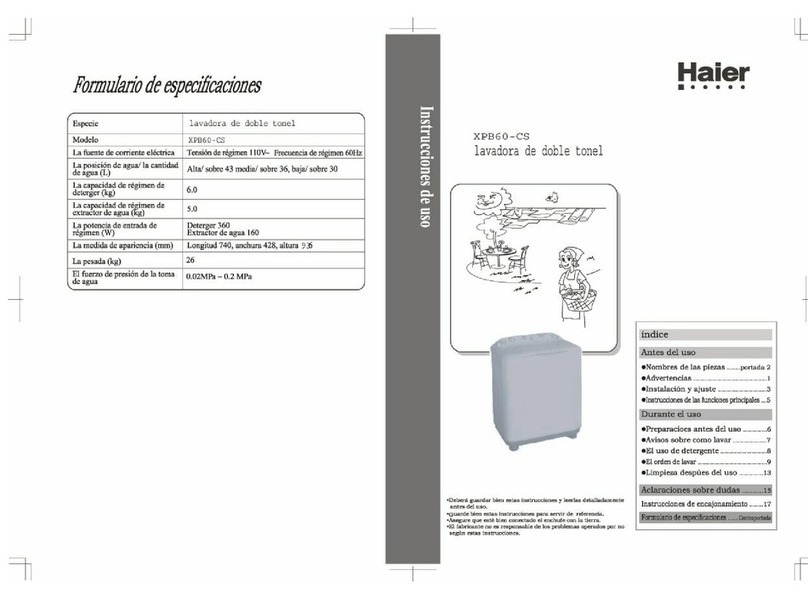
Haier
Haier XPB60-CS Instrucciones de Uso
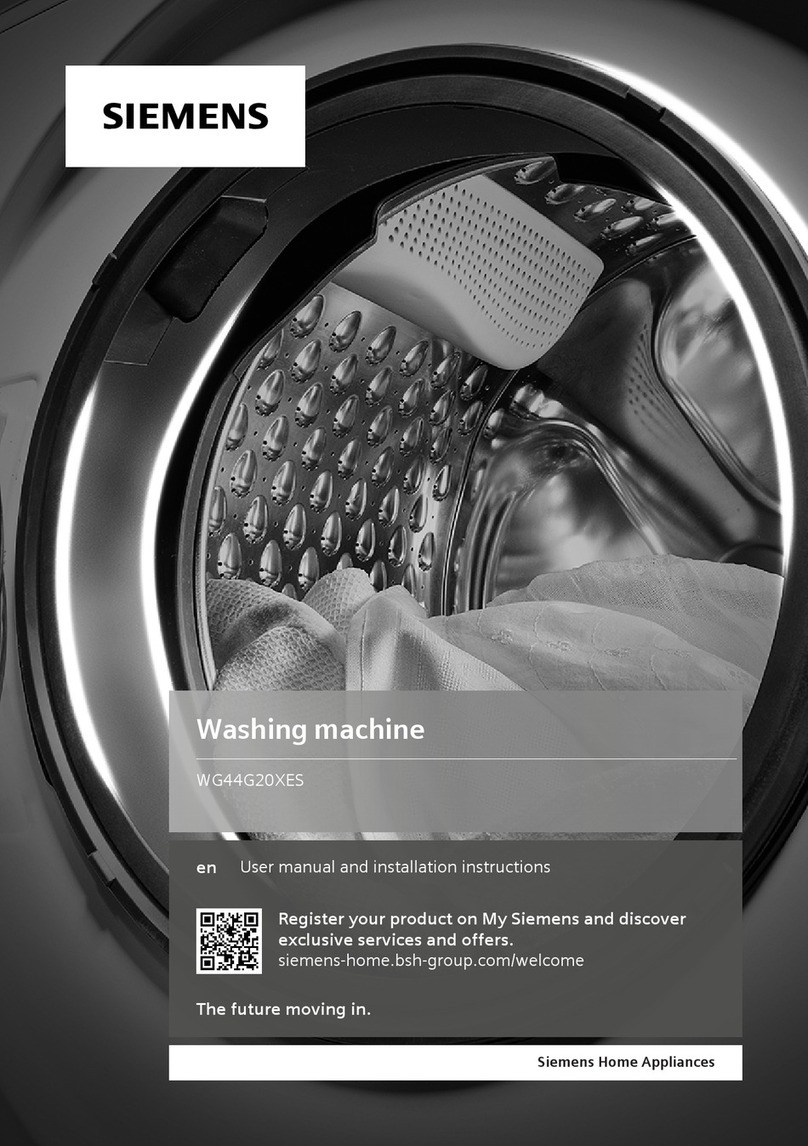
Siemens
Siemens WG44G20XES User manual and installation instructions

GE
GE WWA7345V operating instructions
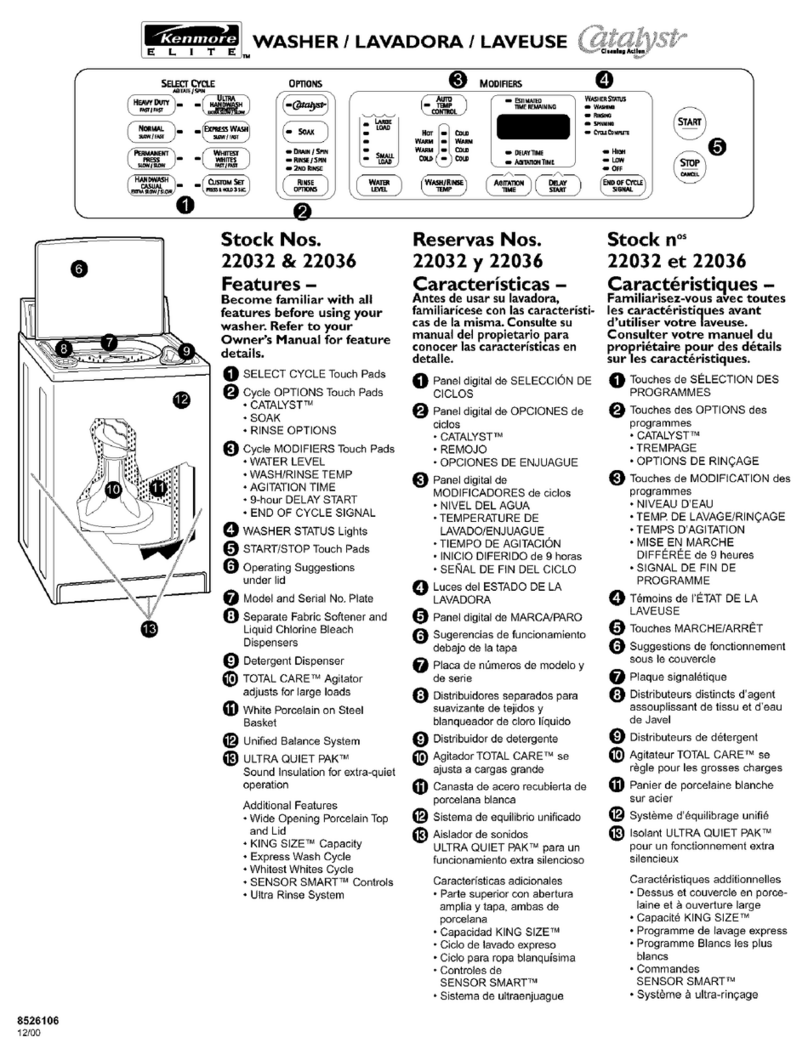
Kenmore
Kenmore 22032 & 22036 quick guide
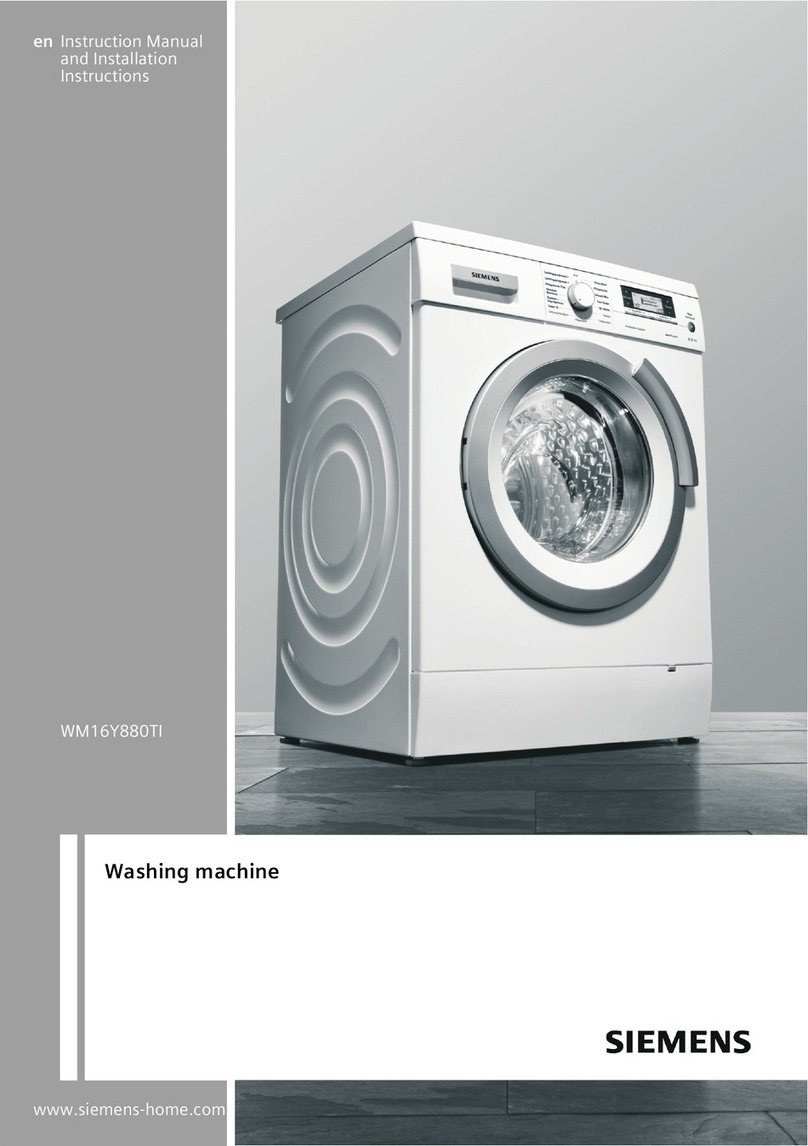
Siemens
Siemens WM16Y880TI Instruction manual and installation instructions

Bosch
Bosch WAK20210ME Instruction manual and installation instructions
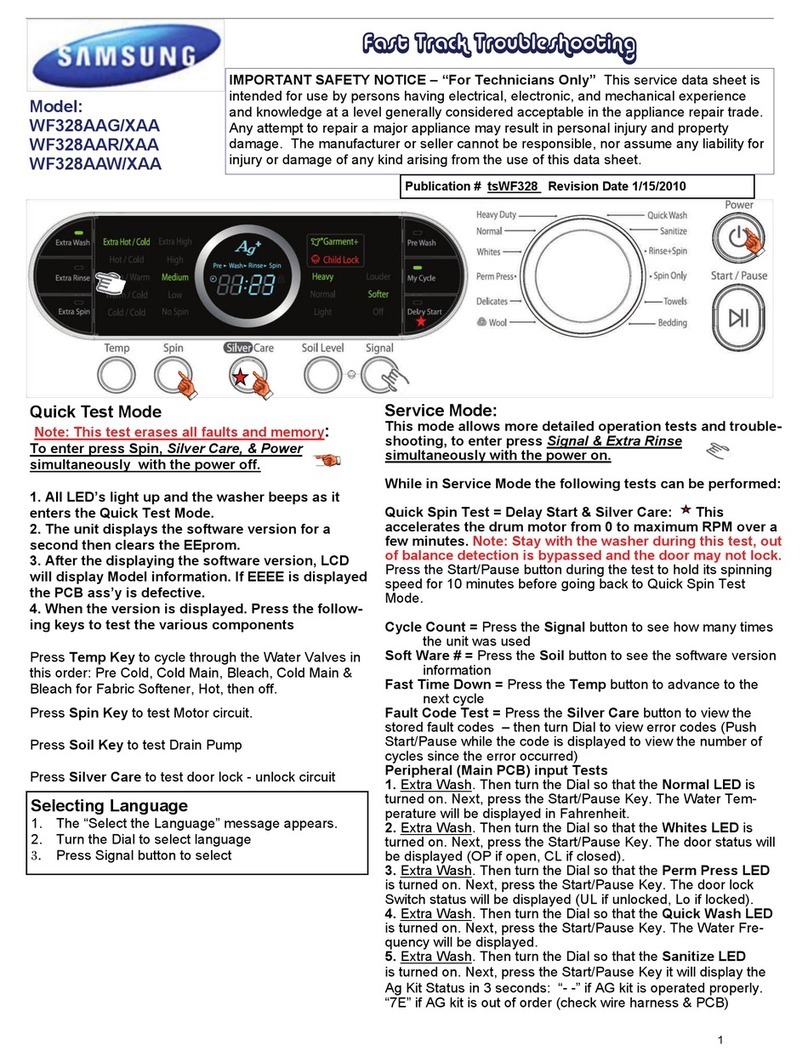
Samsung
Samsung WF328AAG/XAA manual

Siemens
Siemens WM14VKH1ES User manual and installation instructions
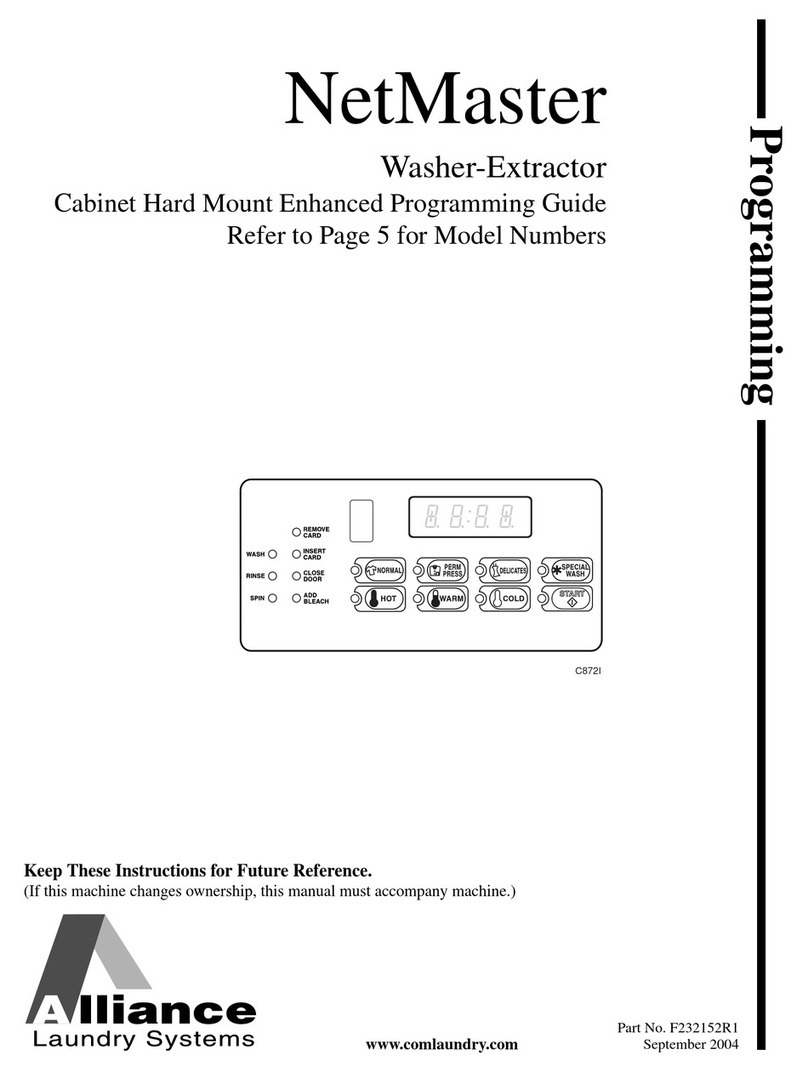
Alliance Laundry Systems
Alliance Laundry Systems NetMaster HC18NC2 Programming manual
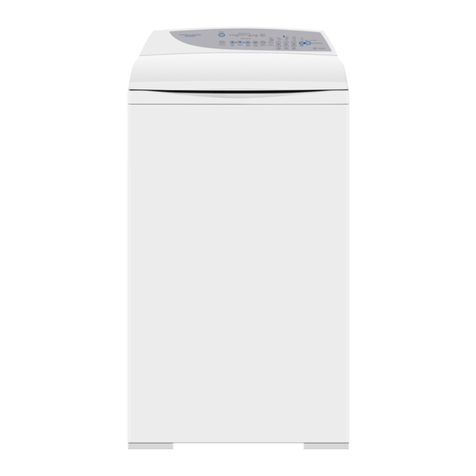
Fisher & Paykel
Fisher & Paykel SMARTDRIVE PHASE 7 Service manual
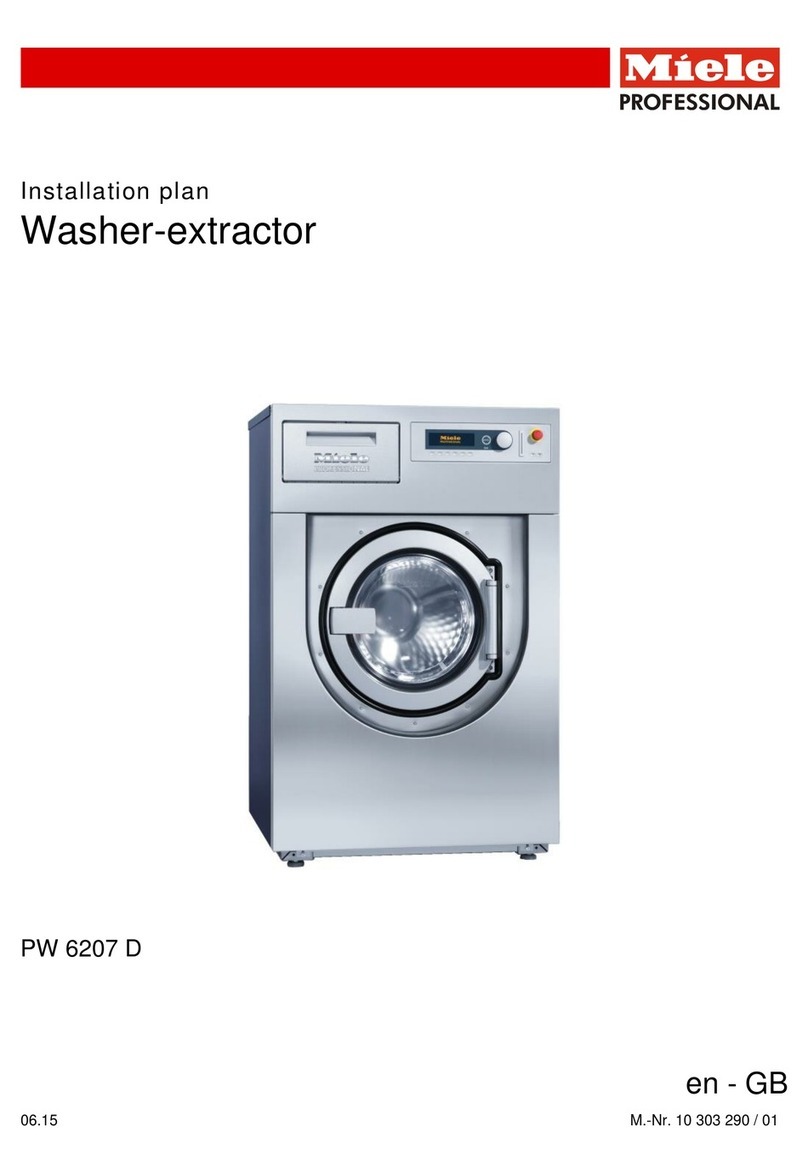
Miele
Miele PW 6207D Installations plan
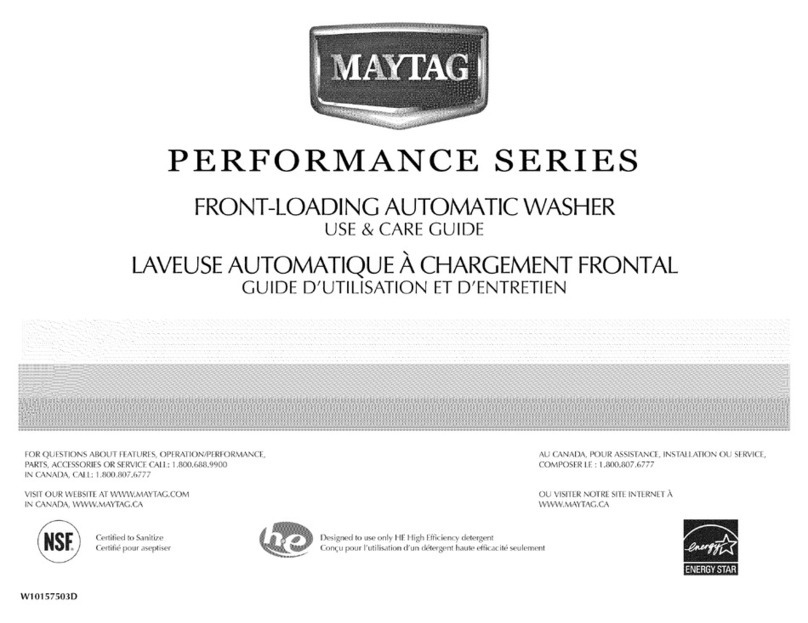
Maytag
Maytag MHWE300VW - Performance Series Front Load... Use and care guide
